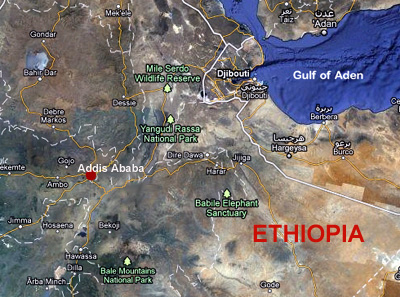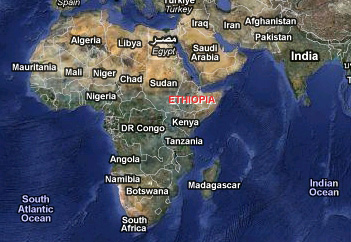Scientist at Work: Paleobotonist Bonnie Jacobs in Ethiopia
An update of SMU paleobotanist Bonnie F. Jacobs blogs from Ethiopia, where she is searching for ancient plant and animal life.


January 10, 2011
Amid the Shales, Glimpses of an Ancient Forest
Today, the blocks were coming out intact — really huge — providing the opportunity to find complete large specimens. Sure enough, we were delighted to find two tremendous elephant ear leaves, both clearly from the same plant, with their petioles (which attach leaves to the stem).
The “oh, wow” occurrences are fun, but these collections will require months of work in the lab to determine how many kinds of leaves (species) we have, how many occur at each locality, and who and where the living relatives of these plants are today. We will also look at each leaf to see how much damage there is from insect feeding, and what sort of insect likely did the damage. More than that, to determine the past climate, the leaves will be measured digitally, their cuticles will be analyzed chemically and the density of their stomata — openings through which carbon dioxide goes in and oxygen and water vapor escape — will be determined as well.
So far, we know the environment in which the plants were preserved was a lake, most likely a crater lake or one dammed by a volcanic eruption. Picture a lake with fish and frogs, aquatic plants including ferns, water lilies and elephant ears. It was surrounded by a forest, one with some trees that today have relatives abundant in west and central Africa, especially legumes. We have not found palms.
Read the complete blog and see photos from the field.
January 3, 2011
Evidence of Mammals and Legumes, 22 Million Years Old
None of us has ever experienced a site like this. Not only are the shales full of leaf fossils, but we have now also found beautiful and important fossil bones, including the tooth of a small mammal and the scapula of an artiodactyl. (This is an order of hoofed animals that are also known as even-toed ungulates — picture a mammal that walks on its tippy-toes, like a gazelle.) . . .
Treats for the paleobotanists include a fossil flower, many seeds, a bean pod with seeds in it and part of a lobed leaf that, when whole, must have been as big as your head (even if you are big-headed). The leaves are quite abundant, so in two days’ work we have already collected more than 300 specimens.
Read the complete blog and see photos from the field.
December 31, 2010
Eureka! A Fossil Bone, and Water Ferns to Boot
We arrived in Addis Ababa via Frankfurt, traveling from Dallas and Chicago, and as usual were bleary-eyed after the 20-plus-hour journey, but happy to be back. We were lucky to have had no delays, no problems with customs, and to have Mesfin, our friend/driver and helper extraordinaire, waiting for us. . .
We were anxious to get to work this morning, and, most gratifyingly, a mere 15-minute hike down to the fossil beds brought us to new discoveries almost immediately. In the first five minutes, Ellen Currano found a fossil bone in about the same spot where we found bones last year. So it’s a good thing we have a vertebrate paleontologist with us.
Read the complete blog and see photos from the field.
December 27, 2010
A Fossil Hunt in Ethiopia’s Mush Valley
This winter’s field season in Ethiopia is my tenth since I began working there, and despite my experience I am filled with anticipation. Our project is a relatively new one — studying rocks and fossils from an important period of history, 22 million years ago — and the location, Mush Valley, is also somewhat new to our team (last year was our first collecting trip here).
Mush Valley is only about 160 kilometers northeast of the modern capital city, Addis Ababa, but it feels as though it could be a thousand miles away. Very little of city life intrudes into the villages of Upper and Lower Mush.
What really takes me away from it all are the rocks and fossils exposed by and alongside the Mush River. They provide us an exciting opportunity to document life, climate, landscape and atmosphere 22 million years ago. As we excavate blocks of fine-grained sediment — primarily shale — looking for clues to the past, the pivotal role played by that ancient time period is always on our mind.
Why is it important to know about the Ethiopian Plateau 22 million years ago? The Mush Valley preserves plants and animals from a time soon after a land connection was established between Afro-Arabia and Eurasia — a land connection that marked the end of Africa’s island status and that was used by animals to migrate between the two previously separated land masses. By looking at the fossil record from that period of time — before the Red Sea was formed — we can gain a clearer view of which species survived this great migration and which did not.
Locating Addis Ababa in Ethiopia
 |
 Maps courtesy of Google Maps. |
# # #